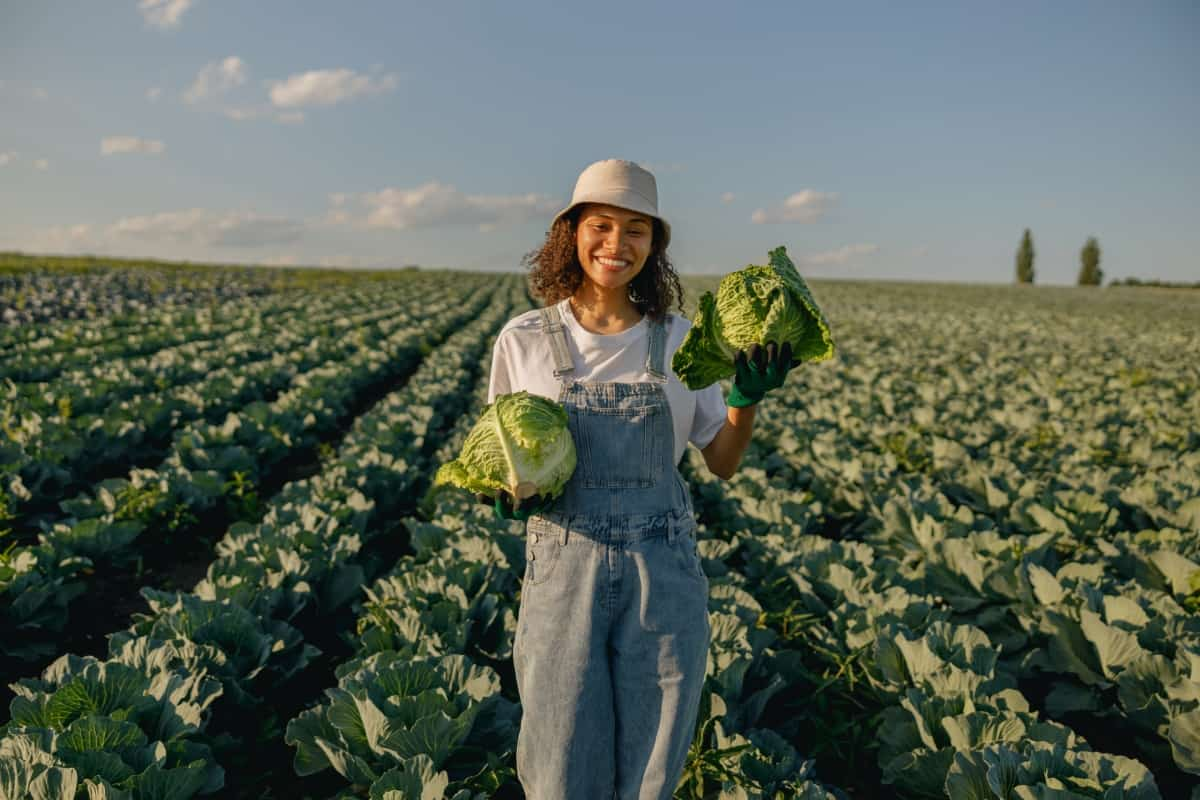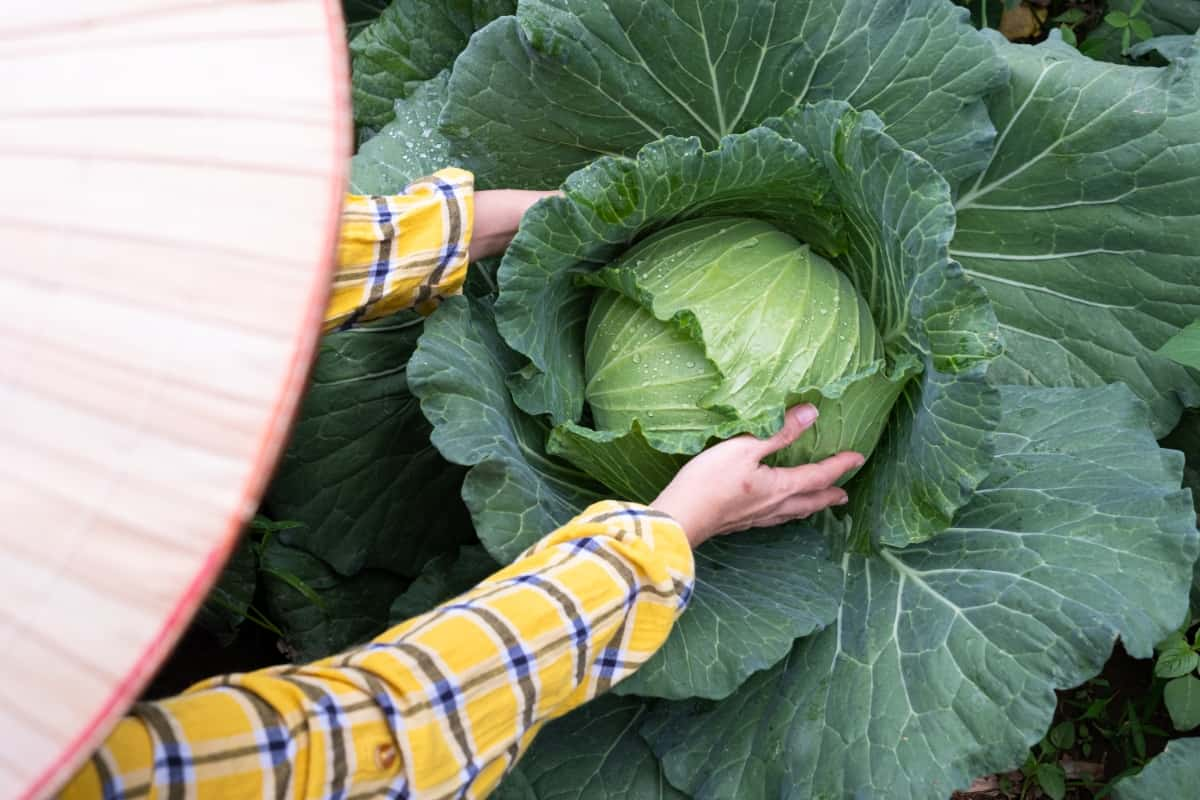Cabbage farming can be a profitable venture if done right. By choosing the suitable variety, preparing the soil, implementing proper planting techniques, managing pests and diseases effectively, adopting sustainable practices, and focusing on marketing strategies, you can maximize your Cabbage yield and make your farm thrive.

Remember that success in Cabbage farming requires careful planning, consistent maintenance, and continuous learning. Stay updated with the latest research and advancements in agricultural practices to stay ahead of potential challenges. With dedication, you can create a thriving Cabbage farm that not only provides you with high-quality produce but also contributes to a healthier food system.
Techniques for Maximizing Cabbage Yield
Choosing the Right Cabbage Varieties for Maximum Yield
Choosing the right Cabbage varieties is crucial for maximizing yield in your farming endeavors. With so many different types of Cabbages available, it can be overwhelming to decide. However, by considering certain factors, you can select the varieties that are best suited to your specific needs. Some Cabbages thrive in cooler temperatures, while others prefer warmer climates.
By choosing varieties that are well adapted to your local weather patterns, you can ensure optimal growth and productivity. Consider the market demand for different Cabbage varieties. It’s important to grow types of Cabbage that have high consumer appeal and are in demand locally or regionally. Certain varieties may be more resistant to common pests and diseases prevalent in your area.
By selecting resistant varieties, you can reduce crop losses due to infestations or infections. Consider the maturity period of different Cabbages when making your selection. If you’re aiming for continuous harvests throughout the season or want an early crop for a specific event or market opportunity, choose varieties with varying maturity dates.
Optimal Soil Preparation Techniques for Cabbage Farming
Cabbages thrive best in a pH range of 6.0 to 7.5. If necessary, adjust the pH by adding lime to raise acidity or sulfur to lower it. Next, clear any weeds or debris from the planting area and till the soil thoroughly to break up clumps and improve drainage. This will create a loose and friable texture that allows roots to penetrate easily.
Incorporating organic matter into the soil is another essential technique. Add well-rotted compost or aged manure before planting, as this enriches the soil with nutrients while improving its structure and water-holding capacity. Prioritize providing adequate levels of nitrogen, phosphorus, and potassium (NPK) – vital nutrients for Cabbage growth.
Implementing Proper Crop Rotation Practices for Increased Cabbage Yield
Implementing proper crop rotation practices is essential for maximizing Cabbage yield on your farm. Crop rotation involves alternating the cultivation of different plant families in a particular field over several seasons. To effectively implement crop rotation for Cabbage farming, it is important to have a thorough understanding of the different plant families and their compatibility with Cabbage.
Avoid planting Cabbages or any other brassica crops in the same area year after year, as this can lead to an accumulation of pests and diseases specific to these plants. Instead, consider rotating Cabbage with non-brassica crops such as Legumes (Peas or Beans), root vegetables (Carrots or Potatoes), or leafy greens (Lettuce or Spinach).
In case you missed it: Growth Stages of Cabbage Plants: Exploring from Germination to Harvesting

These crops help replenish nutrients in the soil that are depleted by brassicas while minimizing the risk of pest infestations. Plan your crop rotation schedule carefully, ensuring that there is at least a two-year gap before reintroducing brassicas into a particular field. This will allow enough time for pests and diseases associated with Cabbage to decline in population naturally.
Effective Seed Starting and Transplanting Methods for Cabbage Farming
To ensure a successful Cabbage harvest, it is crucial to start with healthy and vigorous seedlings. The first step in achieving this is selecting high-quality seeds from reputable suppliers. When it comes to starting the seeds, timing is key. Start the Cabbage seeds indoors about 6-8 weeks before the last frost date. Use clean trays or pots filled with a well-draining seed starting mix.
Maintain consistent moisture levels by misting or using bottom watering techniques until germination occurs. Once the seedlings have emerged, provide them with sufficient light by placing them under grow lights or near a sunny window. Before transplanting the seedlings into the garden, harden them off gradually over 7-10 days. This involves exposing them to outdoor conditions such as wind and sunlight for increasing amounts of time each day.
When it’s time to transplant, prepare the garden bed by loosening the soil and incorporating organic matter such as compost or well-rotted manure. Dig holes larger than the root balls of the seedlings and space them according to recommended guidelines (usually around 12-18 inches apart). Carefully remove each seedling from its container, disturbing its roots as little as possible. Place it in one of the prepared holes, making sure it sits at roughly the same depth as it was growing previously.
Irrigation Strategies to Maximize Cabbage Production
Irrigation plays a crucial role in maximizing Cabbage production. An adequate water supply ensures that the plants get the necessary nutrients and grow to their full potential. It is important to understand the water needs of Cabbages at different stages of growth. Young plants need more frequent watering, while mature ones need deeper irrigation less frequently.
One efficient method is drip irrigation, which delivers water to the roots through a network of tubes or pipes with small holes. This minimizes water wastage and ensures precise delivery where it’s needed most. Another strategy is implementing mulching techniques around the base of the Cabbage plants. Mulch helps retain moisture levels in the soil by reducing evaporation, thus reducing water loss and increasing efficiency.
Nutrient Management for High-Yield Cabbage Farming
Nutrient management plays a key role in ensuring high-yield Cabbage farming. Cabbage plants have specific nutrient requirements throughout their growth cycle, and providing the right balance of nutrients can significantly boost productivity. One important aspect of nutrient management is soil testing. Before planting Cabbage, it’s essential to conduct a soil analysis.
Based on the soil test results, organic matter, and necessary nutrients can be added in the form of compost or well-decomposed manure. Timing is key when applying fertilizers in Cabbage farming. It’s best to split the fertilizer application into multiple doses throughout the growing season. This approach ensures that the plants receive a steady supply of nutrients when they need them most.
Nitrogen is particularly crucial for Cabbage growth as it promotes leaf development and overall plant vigor. However, excessive nitrogen can lead to soft heads or reduced yield quality. Therefore, monitoring nitrogen levels through regular leaf tissue analysis is recommended so that adjustments can be made if needed. In addition to nitrogen, other important macronutrients for Cabbage include phosphorus and potassium. Phosphorus aids in root development, while potassium enhances disease resistance and overall plant health.
Controlling Pests and Diseases in Cabbage Crops to Enhance Yield
Controlling pests and diseases is crucial to ensure high-yield Cabbage farming. These pesky invaders can cause significant damage to your crops, leading to reduced yields and lower quality produce. To enhance yield, it’s essential to implement effective pest and disease management strategies. One key approach is practicing regular scouting in your Cabbage field. By closely monitoring your plants for signs of pests or diseases, you can catch any issues early on and take appropriate action.
This could involve physically removing pests like caterpillars or aphids by hand or using organic insecticides if necessary. Another important step is promoting biodiversity in your farm ecosystem. Encouraging beneficial insects helps control common Cabbage pests like aphids and whiteflies naturally. Additionally, rotating different crops each season can disrupt the life cycle of many pests, reducing their populations over time.
In case you missed it: Growing Cabbage in Containers: Growing Cabbage in Small Spaces with Pots

Maintaining proper sanitation practices is also vital in pest and disease control. Remove any damaged plant material promptly to prevent the spread of pathogens. Clean tools regularly between uses to avoid cross-contamination. Furthermore, utilizing biological controls such as nematodes or microbial pesticides can be an effective way to manage specific pests without harming beneficial insects or pollinators.
Weed Control Techniques for Maximizing Cabbage Yield
One of the key challenges in Cabbage farming is weed control. Weeds compete with Cabbage plants for nutrients, water, and sunlight, which can significantly reduce yield. Therefore, implementing effective weed control techniques is crucial for maximizing Cabbage production. A proactive approach to weed management starts even before planting. Clearing the field of any existing weeds and their seeds helps prevent future infestations.
Additionally, practicing crop rotation can disrupt weed life cycles and minimize their impact on Cabbage crops. During the growing season, regular cultivation or hoeing around the plants helps remove young weeds before they become established. Hand-weeding may be necessary in areas where machinery cannot reach or when dealing with persistent weeds.
Harvesting and Post-Harvest Handling Practices for Maximum Cabbage Yield
Harvesting and post-harvest handling practices play a crucial role in maximizing Cabbage yield. When it comes to harvesting Cabbage, timing is key. It’s important to wait until the heads are firm and have reached their full size before cutting them from the plant. This ensures that you get the maximum yield from each head.
To harvest Cabbage, you can use a sharp knife to cut the head off at its base, leaving a few outer leaves attached for protection during transportation and storage. Be careful not to damage the surrounding heads or nearby plants while harvesting. Once harvested, proper post-harvest handling techniques are essential for preserving Cabbage quality and extending its shelf life.
Utilizing Crop Coverings and Mulching to Boost Cabbage Production
Crop coverings and mulching are two effective techniques that can significantly enhance Cabbage production. One way to utilize crop coverings is by using row covers or tunnels. These protective structures shield the plants from harsh weather conditions like extreme temperatures, heavy rain, and strong winds. They also provide a microclimate that promotes faster growth and protects the plants from pests. Mulching is another valuable technique in Cabbage farming.
In case you missed it: Cabbage Farming in Vertical Systems: Growing Cabbage in Vertical Spaces

Applying organic mulch around the plants helps retain moisture in the soil, prevents weed growth, and regulates soil temperature. Straw mulch or compost can be used as organic materials for mulching Cabbage crops. These materials not only improve soil fertility but also act as a barrier against diseases that may attack the plant through direct contact with the ground. Additionally, mulches help conserve water by reducing evaporation from the soil surface. This is particularly beneficial during dry periods when irrigation may be limited.
Conclusion
Mastering the techniques involved in Cabbage farming will enable you to reap bountiful harvests while contributing to local food security. Whether you’re an experienced farmer looking for new cultivation methods or someone interested in sustainable agriculture practices at home, incorporating these strategies will undoubtedly lead you toward success in Cabbage farming.
- Feed Your Flock for Less: Top 10 Tips to Save on Chicken Feed
- Ultimate Guide to Ossabaw Island Hog: Breeding, Raising, Diet, and Care
- Hatching Answers: The Top 10 Reasons Your Chickens Aren’t Laying Eggs
- Eggs and Economics: Breaking Down the Cost of Raising Backyard Chickens
- Defend Your Greens: Proven Methods to Keep Iguanas Out of Your Garden
- Ultimate Guide to Cinnamon Queen Chicken: A Comprehensive Guide for Beginners
- Ultimate Guide to California Tan Chicken: Breeding, Raising, Diet, Egg-Production and Care
- Ultimate Guide to Marsh Daisy Chicken: Breeding, Raising, Diet, and Care
- 10 Types of Chicken Farming Businesses You Can Start for Profits